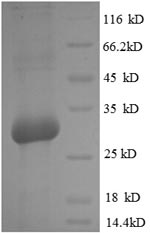Recombinant Rat Osteocalcin (Bglap) is expressed in E. coli and includes an N-terminal GST tag that makes purification more straightforward. The protein contains the full length of mature osteocalcin—specifically the 50-99 amino acid region. SDS-PAGE analysis confirms purity levels above 90%, suggesting this is a reliable reagent for research work.
Osteocalcin, sometimes called bone gamma-carboxyglutamic acid-containing protein, seems to play a central role in how bones metabolize and mineralize. Osteoblasts produce this protein, and it likely helps regulate bone formation and calcium ion balance. Many researchers study osteocalcin as a marker of bone turnover, making it an attractive target for investigations into bone health and metabolic diseases.
Potential Applications
Note: The applications listed below are based on what we know about this protein's biological functions, published research, and experience from experts in the field. However, we haven't fully tested all of these applications ourselves yet. We'd recommend running some preliminary tests first to make sure they work for your specific research goals.
Rat osteocalcin (Bglap) is a small, secreted protein that requires specific post-translational modifications (particularly gamma-carboxylation of glutamic acid residues) for its calcium-binding activity and biological function in bone mineralization. The E. coli expression system cannot perform these vitamin K-dependent carboxylation modifications. While the protein may achieve some level of secondary structure, it will lack the critical gamma-carboxyl groups necessary for functional activity. The GST tag may help with solubility, but it does not compensate for the missing modifications. Therefore, this recombinant protein is highly unlikely to be functionally active, though it may have some structural elements.
1. Antibody Development and Validation
This recombinant osteocalcin serves as an excellent immunogen for generating antibodies specific to the rat osteocalcin sequence. The high purity and full-length mature protein sequence ensure broad epitope coverage. These antibodies will be valuable for detecting both modified and unmodified forms of osteocalcin in techniques like Western blotting. However, they may have varying affinity for the gamma-carboxylated form found in biological systems.
2. ELISA Development
This protein is well-suited as a standard for quantitative ELISA assays to measure total osteocalcin immunoreactivity. As an immunoassay standard, the protein's sequence and purity are sufficient. For functional binding studies, the missing modifications make it inappropriate.
3. Biochemical Characterization and Stability Studies
This is an essential application for understanding the properties of this specific recombinant protein. Techniques like circular dichroism can assess its secondary structure content, while thermal shift assays can determine its stability under various conditions. These studies provide crucial quality control data and help understand how the lack of gamma-carboxylation affects the protein's physical properties.
Final Recommendation & Action Plan
This recombinant osteocalcin is valuable for immunological and biochemical characterization applications but unsuitable for functional studies requiring native post-translational modifications. The recommended approach is to prioritize Application 3 (Biochemical Characterization) to establish the protein's stability and structural properties, then proceed confidently with Application 1 (Antibody Development) and Application 2 (as an ELISA standard). For interaction studies, the protein should only be used for preliminary screening with the understanding that all findings must be validated using properly carboxylated osteocalcin from mammalian sources. For functional binding studies, alternative approaches using osteocalcin from mammalian expression systems or native purification from bone tissue are necessary to obtain biologically relevant results.






